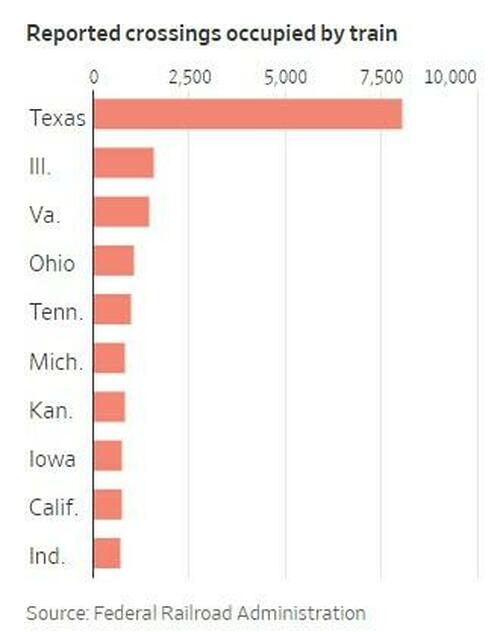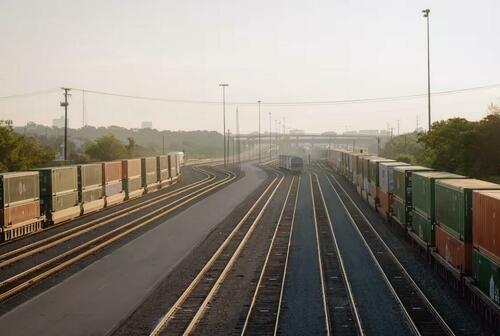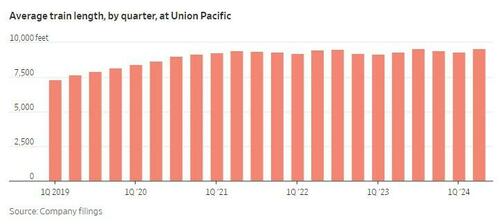Texas freight trains are become a problem when they cross busy roadways. With some trains now 3 miles or longer in length, places like Pleasantville, Texas often see traffic waiting for up to 7 minutes for them to pass.
The town is near rail yards run by Union Pacific, Wall Street Journal highlighted in a new article. It says the 'monster trains' are a way to make higher profits because they can haul more goods with less locomotives and less crew.
There are no federal limits on train length, though regulators are reviewing the issue, the report says. Over a dozen states, including Texas, have proposed limiting trains to 1.6 miles, but they can't enforce these laws due to interstate commerce rules.
Union Pacific, the top source of blocked crossing complaints, runs trains up to 3.8 miles long. Last quarter, its average train length was 1.8 miles, up from 1.3 miles in 2018.
The Wall Street Journal article reports that long trains move slowly, causing longer waits for drivers, and when they stop, it worsens. School buses, ambulances, and firetrucks face delays, while pedestrians and cyclists sometimes risk their lives by crossing between train cars.
In July, a 27-year-old woman in Texas died doing so when the train started moving. Texas leads the nation in blocked rail crossings, with over 8,000 reports in the past year, compared to 1,600 in Illinois. Rising population and container traffic from Gulf Coast ports have made blocked crossings more common in Texas.
“Any time a train operates through a community—whether it’s 3,000-feet-long or whether it’s 10,000-feet-long—you know you’re going to impact roadways, the communities,” commented Jim Vena, chief executive of Union Pacific.
Railroads also argue that long trains help reduce greenhouse gas emissions, while labor unions claim they increase safety risks and threaten jobs.
A 3-mile train moving at 25 mph takes about 7 minutes and 12 seconds to clear a crossing, plus 20 seconds for the gate warning.
Ramon Rios has a special needs son with a service driver, who sometimes calls to tell him trains are delaying his ride home.
“But if you get caught right at the train tracks and you’ve traffic behind you, you can’t get out,” the 70-year-old said.
“I ask where he’s stopped at and I say, ‘Yeah, I know exactly where you’re at,'" he told the Journal. “You’ve got to stay to wait for the train to go by. And then if it’s hot, it definitely sucks.”
Letitia Plummer, a Houston City Council member concluded: “People can’t get to work on time in the mornings or get back home in the evenings. And now our babies are crawling underneath the trains to cross the railroad tracks.”
Texas freight trains are become a problem when they cross busy roadways. With some trains now 3 miles or longer in length, places like Pleasantville, Texas often see traffic waiting for up to 7 minutes for them to pass.
The town is near rail yards run by Union Pacific, Wall Street Journal highlighted in a new article. It says the 'monster trains' are a way to make higher profits because they can haul more goods with less locomotives and less crew.
There are no federal limits on train length, though regulators are reviewing the issue, the report says. Over a dozen states, including Texas, have proposed limiting trains to 1.6 miles, but they can't enforce these laws due to interstate commerce rules.
Union Pacific, the top source of blocked crossing complaints, runs trains up to 3.8 miles long. Last quarter, its average train length was 1.8 miles, up from 1.3 miles in 2018.
The Wall Street Journal article reports that long trains move slowly, causing longer waits for drivers, and when they stop, it worsens. School buses, ambulances, and firetrucks face delays, while pedestrians and cyclists sometimes risk their lives by crossing between train cars.
In July, a 27-year-old woman in Texas died doing so when the train started moving. Texas leads the nation in blocked rail crossings, with over 8,000 reports in the past year, compared to 1,600 in Illinois. Rising population and container traffic from Gulf Coast ports have made blocked crossings more common in Texas.
“Any time a train operates through a community—whether it’s 3,000-feet-long or whether it’s 10,000-feet-long—you know you’re going to impact roadways, the communities,” commented Jim Vena, chief executive of Union Pacific.
Railroads also argue that long trains help reduce greenhouse gas emissions, while labor unions claim they increase safety risks and threaten jobs.
A 3-mile train moving at 25 mph takes about 7 minutes and 12 seconds to clear a crossing, plus 20 seconds for the gate warning.
Ramon Rios has a special needs son with a service driver, who sometimes calls to tell him trains are delaying his ride home.
“But if you get caught right at the train tracks and you’ve traffic behind you, you can’t get out,” the 70-year-old said.
“I ask where he’s stopped at and I say, ‘Yeah, I know exactly where you’re at,'" he told the Journal. “You’ve got to stay to wait for the train to go by. And then if it’s hot, it definitely sucks.”
Letitia Plummer, a Houston City Council member concluded: “People can’t get to work on time in the mornings or get back home in the evenings. And now our babies are crawling underneath the trains to cross the railroad tracks.”



